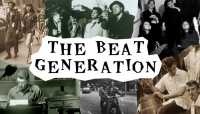Difference between revisions of "The LGBTQ Community and the Beat Generation"
| (One intermediate revision by the same user not shown) | |||
| Line 27: | Line 27: | ||
* [[LGBTQ Participation in the Harlem Renaissance]] | * [[LGBTQ Participation in the Harlem Renaissance]] | ||
* [[The Violet Quill Author's Group]] | * [[The Violet Quill Author's Group]] | ||
| + | * [[The Bloomsbury Group in LGBTQ History]] | ||
==Further Reading/Research== | ==Further Reading/Research== | ||
| Line 33: | Line 34: | ||
* https://qssfc.wordpress.com/2012autumn/sexuality-in-the-beat-generation/ | * https://qssfc.wordpress.com/2012autumn/sexuality-in-the-beat-generation/ | ||
* http://jimburroway.com/history/the-homosexual-and-the-beat-generation/ | * http://jimburroway.com/history/the-homosexual-and-the-beat-generation/ | ||
| − | * | + | * https://www.newyorker.com/books/double-take/sunday-reading-the-beat-generation |
<html><br /> | <html><br /> | ||
Latest revision as of 19:37, 30 July 2023
The Beat Generation was an influential literary and artistic collective of young Americans in the mid 1950s who were avant garde in opposing the standardized and normative values of mass society being created by the post-war, Cold War crusading government of the time. This group preceded the Hippie Generation and embraced drugs, alcohol, new music, and homosexuality - values and behaviours which directly contradicted the norms of society at the time. The group emerged in New York's Greenwich Village but spread westward to San Francisco. They were always small in number but influential, being innovative artists and non-conformist free thinkers.
As such, the LGBTQ community was very present in the Beat Generation. Its emergence coincided with the creation of the Mattachine Society, one of the earliest gay organizations in America. The group's informal leaders included poet Allen Ginsberg and writer William S. Burroughs. These writers and poets included homosexuality openly in their work thereby shocking society, encouraging censorship which helped to liberalize publishing in the future. Photographer Robert Giard documented many of the personalities in the group through his photography, and their movement inspired sexual researcher Alfred Kinsey in his path-breaking work. Gore Vidal characterized the group in his popular writings and filmmaker John Krokidas documented them in his 2013 film 'Kill Your Darlings'.
The Beat Generation represented the gay political scene that emerged after the war period and which ultimately led to Stonewall and other historical markers for the LGBTQ community and its march toward equality and acceptance. Though the Beat Generation was short-lived, it spawned the next generation of hippies, peace activists, social activists, gay leathermen, butch dykes, and LGBTQ activists.
We present the following individuals as having connections to the Beat Generation. Simply click on their names to read their fascinating biographies.
- James Broughton - poet, playwright and filmmaker
- William S. Burroughs - author
- Lucien Carr - journalist
- Robert Duncan - poet
- Robert Giard - photographer
- Allen Ginsberg - poet and LGBTQ activist
- Herbert Huncke - poet and author
- Alfred Kinsey - academic
- John Krokidas - filmmaker
- Peter Orlovsky - poet and author
- Michael Rumaker - poet and writer
- Edward Sagarin - academic
- Gore Vidal - writer
See Also
- LGBTQ Participation in the Harlem Renaissance
- The Violet Quill Author's Group
- The Bloomsbury Group in LGBTQ History

